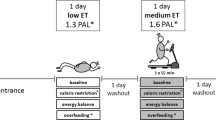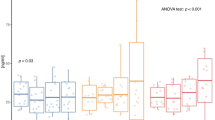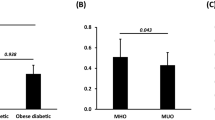Abstract
OBJECTIVE: A low-fat, high-carbohydrate diet (≤30% of total energy intake as fat) in conjunction with moderate intensity physical activity is widely recommended for weight maintenance and reduction. The aim of this study was to assess the effect of adding daily exercise to a short-term high-carbohydrate diet on fasting and postprandial leptin levels.
SUBJECTS: Eight healthy, postmenopausal women aged 60±4 y (mean±s.d.) (body mass index, BMI: 26.4±2.3 kg m−2; predicted maximal oxygen uptake: 29±2 ml kg−1 min−1).
DESIGN: Plasma responses were studied after subjects consumed the same high-fat, mixed meal on three occasions: after 3 days on a low-carbohydrate diet (35, 50 and 15% energy from carbohydrate, fat and protein, respectively) (Low-CHO); after 3 days on an isoenergetic high-carbohydrate diet (corresponding values 70, 15 and 15%) (High-CHO); and after 3 days on the same high-carbohydrate diet with 60 min of brisk walking daily (High-CHO-Ex).
MEASUREMENTS: Fasting and postprandial plasma or serum concentrations of leptin, glucose and insulin.
RESULTS: Fasting leptin was significantly higher (P<0.05) after the High-CHO (18.4±2.6 ng ml−1) (mean±s.e.m.) than after both the Low-CHO and the High-CHO-Ex interventions, which did not differ significantly from each other (16.9±2.1 and 15.5±2.0 ng ml−1, respectively; P=0.08). Overall (fasted and postprandial states), plasma leptin concentrations were significantly higher after the High-CHO than after the High-CHO-Ex intervention. There was a strong, positive, linear relation between postprandial insulin responses and postprandial leptin concentrations at 6 h. In addition, there was a strong, negative, linear relation between whole-body insulin sensitivity (based on postprandial responses of glucose and insulin) and postprandial leptin concentrations at 6 h.
CONCLUSION: Daily moderate intensity exercise, without concomitant changes in body fat mass, suppressed fasting and postprandial circulating leptin concentrations after consumption of a short-term high-carbohydrate diet. As shown in previous studies, insulin appears to be an important modulator of leptinaemia.
This is a preview of subscription content, access via your institution
Access options
Subscribe to this journal
Receive 12 print issues and online access
$259.00 per year
only $21.58 per issue
Buy this article
- Purchase on Springer Link
- Instant access to full article PDF
Prices may be subject to local taxes which are calculated during checkout



Similar content being viewed by others
References
Friedman JM, Halaas JL . Leptin and the regulation of body weight in mammals. Nature 1998; 395: 763–770.
Havel PJ . Control of energy homeostasis and insulin action by adipocyte hormones: leptin, acylation stimulating protein, and adiponectin. Curr Opin Lipidol 2002; 13: 51–59.
Romon M, Lebel P, Velly C, Marecaux N, Fruchart JC, Dallongeville J . Leptin response to carbohydrate or fat meal and association with subsequent satiety and energy intake. Am J Physiol 1999; 277: E855–E861.
Considine RV, Sinha MK, Heiman ML, Kriauciunas A, Stephens TW, Nyce MR, Ohannesian JP, Marco CC, McKee LJ, Bauer TL, Caro JF . Serum immunoreactive-leptin concentrations in normal-weight and obese humans. N Engl J Med 1996; 334: 292–295.
Weigle DS, Duell PB, Connor WE, Steiner RA, Soules MR, Kuijper JL . Effect of fasting, refeeding, and dietary fat restriction on plasma leptin levels. J Clin Endocrinol Metab 1997; 82: 561–565.
Havel PJ, Townsend R, Chaump L, Teff K . High-fat meals reduce 24-h circulating leptin concentrations in women. Diabetes 1999; 48: 334–341.
Lissner L, Levitsky DA, Strupp BJ, Kalkwarf HJ, Roe DA . Dietary fat and the regulation of energy intake in human subjects. Am J Clin Nutr 1987; 46: 886–892.
Schaefer EJ, Lichtenstein AH, Lamon-Fava S, McNamara JR, Schaefer MM, Rasmussen H, Ordovas JM . Body weight and low-density lipoprotein cholesterol changes after consumption of a low-fat ad libitum diet. JAMA 1995; 274: 1450–1455.
Kasim-Karakas SE, Almario RU, Mueller WM, Peerson J . Changes in plasma lipoproteins during low-fat, high-carbohydrate diets: effects of energy intake. Am J Clin Nutr 2000; 71: 1439–1447.
Hickey MS, Israel RG . Exercise and adipose tissue production of cytokines. In: Nicklas B (ed.). Endurance exercise and adipose tissue. CRC Press LLC: Boca Raton, FL; 2002. pp 79–100.
Hickey MS, Houmard JA, Considine RV, Tyndall GL, Midgette JB, Gavigan KE, Weidner ML, McCammon MR, Israel RG, Caro JF . Gender-dependent effects of exercise training on serum leptin levels in humans. Am J Physiol 1997; 272: E562–E566.
van Aggel-Leijssen DPC, van Baak MA, Tenenbaum R, Campfield LA, Saris WHM . Regulation of average 24 h human plasma leptin level; the influence of exercise and physiological changes in energy balance. Int J Obes Relat Metab Disord 1999; 23: 151–158.
NHLBI. Clinical guidelines on the identification, evaluation, and treatment of overweight and obesity in adults. NIH Publication no. 98-4083; 1998. pp 1–262.
Krauss RM, Eckel RH, Howard BV, Appel LJ, Daniels SR, Deckelbaum RJ, Erdman JW, Kris-Etherton P, Goldberg IJ, Kotchen T, Lichtenstein AH, Mitch WE, Mullis R, Robinson K, Wylie-Rosett J, Jeor SS, Suttie J, Tribble DL, Bazzarre TL . AHA dietary guidelines. Revision 2000: a statement for healthcare professionals from the nutrition committee of the American Heart Association. Circulation 2000; 102: 2284–2299.
Saad MF, Khan A, Sharma A, Michael R, Riad-Gabriel MG, Boyadjian R, Jinagouda SD, Steil GM, Kamdar V . Physiological insulinemia acutely modulates plasma leptin. Diabetes 1998; 47: 544–549.
Koutsari C, Karpe F, Humphreys SM, Frayn KN, Hardman AE . Exercise prevents the accumulation of triglyceride-rich lipoproteins and their remnants seen when changing to a high-carbohydrate diet. Arterioscl Thromb Vasc Biol 2001; 21: 1520–1525.
Belfiore F, Iannello S, Camuto M, Fagone S, Cavaleri A . Insulin sensitivity of blood glucose versus insulin sensitivity of blood free fatty acids in normal, obese, and obese-diabetic subjects. Metabolism 2001; 50: 573–582.
Havel PJ, Kasim-Karakas SE, Mueller W, Johnson PR, Ginsberg RL, Stern JS . Relationship of plasma leptin to plasma insulin and adiposity in normal weight women: effects of dietary fat content and sustained weight loss. J Clin Endocrinol Metab 1996; 81: 4406–4413.
Schrauwen P, van Marken WD, Westerterp KR, Saris WHM . Effect of diet composition on leptin concentration in lean subjects. Metabolism 1997; 46: 420–424.
Raben A, Astrup A . Leptin is influenced both by predisposition to obesity and diet composition. Int J Obes Relat Metab Disord 2000; 24: 450–459.
Kohrt WM, Landt M, Birge SJ . Serum leptin levels are reduced in response to exercise training, but not hormone replacement therapy, in older women. J Clin Endocrinol Metab 1996; 81: 3980–3985.
Perusse L, Collier G, Gagnon J, Leon AS, Rao DC, Skinner JS, Wilmore JH, Nadeau A, Zimmet PZ, Bouchard C . Acute and chronic effects of exercise on leptin levels in humans. J Appl Physiol 1997; 83: 5–10.
Kraemer RR, Kraemer GR, Acevedo EO, Hebert EP, Temple E, Bates M, Etie A, Haltom R, Quinn S, Castracane VD . Effects of aerobic exercise on serum leptin levels in obese women. Eur J Appl Physiol 1999; 80: 154–158.
Dirlewanger M, Di Vetta V, Giusti V, Schneiter P, Jequier E, Tappy L . Effect of moderate physical activity on plasma leptin concentration in humans. Eur J Appl Physiol 1999; 79: 331–335.
Kieffer T, Habener J . The adipoinsular axis: effects of leptin on pancreatic β-cell. Am J Physiol 2000; 278: E1–E14.
Coppack SW, Pinkney JH, Mohamed-Ali V . Leptin production in human adipose tissue. Proc Nutr Soc 1998; 57: 461–470.
Evans K, Clark ML, Frayn KN . Carbohydrate and fat have different effects on plasma leptin concentrations and adipose tissue leptin production. Clin Sci 2001; 100: 493–498.
Imbeault P, Doucet E, Mauriege P, St-Pierre S, Couillard C, Almeras N, Despres J-P, Tremblay A . Difference in leptin response to a high-fat meal between lean and obese men. Clin Sci 2001; 101: 359–365.
Mueller WM, Gregoire FM, Stanhope KL, Mobbs CV, Mizuno TM, Warden CH, Stern JS, Havel PJ . Evidence that glucose metabolism regulates leptin secretion from cultured adipocytes. Endocrinology 1998; 139: 551–558.
Wellhoener P, Fruehwald-Schultes B, Kern W, Dantz D, Kerner W, Born J, Fehm HL, Peters A . Glucose metabolism rather than insulin is a main determinant of leptin secretion in humans. J Clin Endocrinol Metab 2000; 85: 1267–1271.
Coppack SW, Fisher RM, Gibbons GF, Humpreys SM, McDonough MJ, Potts JL, Frayn KN . Postprandial substrate disposition in human forearm and adipose tissues in vivo. Clin Sci 1990; 79: 339–348.
Malkova D, Evans RD, Frayn KN, Humphreys SM, Jones PRM, Hardman AE . Prior exercise and postprandial substrate extraction across the human leg. Am J Physiol 2000; 279: E1020–E1028.
Trayhurn P, Duncan JS, Hoggard N, Rayner DV . Regulation of leptin production: a dominant role for the sympathetic nervous system? Proc Nutr Soc 1998; 57: 413–419.
Couillard C, Mauriege P, Prud'homme D, Nadeau A, Tremblay A, Bouchard C, Despres J-P . Plasma leptin response to an epinephrine infusion in lean and obese women. Obes Res 2002; 10: 6–13.
Keim NL, Stern JS, Havel PJ . Relation between circulating leptin concentrations and appetite during a prolonged, moderate energy deficit in women. Am J Clin Nutr 1998; 68: 794–801.
Acknowledgements
This study was funded in part by British Heart Foundation Grant PG/99113. Christina Koutsari was supported by the Greek State Scholarships Foundation. We thank the subjects for their participation, and Jane Riley, Julia Wells and Professor Peter RM Jones for assistance with data collection.
Author information
Authors and Affiliations
Corresponding author
Rights and permissions
About this article
Cite this article
Koutsari, C., Karpe, F., Humphreys, S. et al. Plasma leptin is influenced by diet composition and exercise. Int J Obes 27, 901–906 (2003). https://doi.org/10.1038/sj.ijo.0802322
Received:
Revised:
Accepted:
Published:
Issue Date:
DOI: https://doi.org/10.1038/sj.ijo.0802322
Keywords
This article is cited by
-
Restricting sugar or carbohydrate intake does not impact physical activity level or energy intake over 24 h despite changes in substrate use: a randomised crossover study in healthy men and women
European Journal of Nutrition (2022)
-
Endurance Training Increases Leptin Expression in the Retroperitoneal Adipose Tissue of Rats Fed with a High-Sugar Diet
Lipids (2014)
-
Circulating leptin levels are associated with physical activity or physical fitness in Japanese
Environmental Health and Preventive Medicine (2014)
-
Changes in weight loss, body composition and cardiovascular disease risk after altering macronutrient distributions during a regular exercise program in obese women
Nutrition Journal (2010)
-
Leptin levels and leptin receptor polymorphism frequency in healthy populations
Infectious Agents and Cancer (2009)



